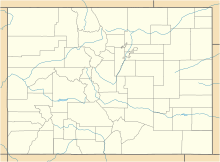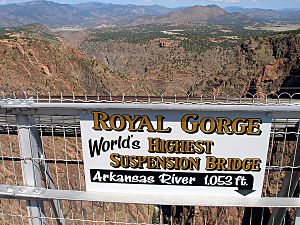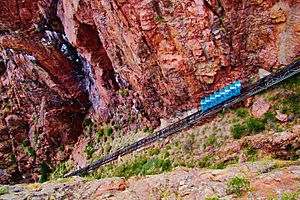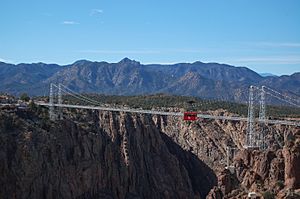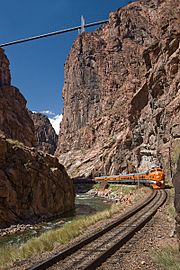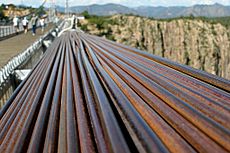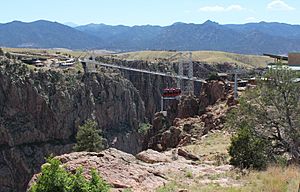Royal Gorge Bridge facts for kids
Quick facts for kids |
|
|
Royal Gorge Bridge
|
|
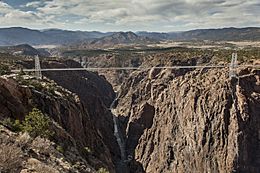 |
|
| Location | Crosses the Arkansas River in Fremont County, Colorado |
|---|---|
| Nearest city | Cañon City |
| NRHP reference No. | 83001303 |
| Added to NRHP | September 2, 1983 |
| Royal Gorge Bridge | |
|---|---|
| Carries | Pedestrians and passenger vehicles |
| Crosses | Arkansas River |
| Owner | City of Cañon City, Colorado |
| Characteristics | |
| Design | Suspension |
| Material | Steel with timber deck |
| Total length | 1,260 ft (384 m) |
| Width | 18 ft (5.5 m) |
| Longest span | 880 ft (268 m) |
| Load limit | 2,000,000 pounds (910 t) |
| Clearance below | 955 ft (291 m) |
| History | |
| Designer | George E. Cole |
| Constructed by | George E. Cole Construction Co. |
| Fabrication by | Colorado Fuel and Iron Corp. |
| Construction begin | June 5, 1929 |
| Construction end | November 1929 |
| Construction cost | $350,000 |
| Opened | December 8, 1929 |

Local area map
|
|
The Royal Gorge Bridge is a famous tourist attraction near Cañon City, Colorado. It's part of the Royal Gorge Bridge & Park, a large amusement park. The park covers 360 acres (150 ha) and is located along the edge of the Royal Gorge.
The bridge crosses the gorge 955 feet (291 m) above the Arkansas River. From 1929 until 2001, it was the highest bridge in the world. It was then surpassed by the Liuguanghe Bridge in China. The Royal Gorge Bridge also held the title of the world's highest suspension bridge until 2003. That's when the Beipan River Guanxing Highway Bridge, also in China, was completed.
Even though other bridges are now higher, the Royal Gorge Bridge is still the highest bridge in the United States. It was among the top ten highest bridges globally until 2012.
The main part of the bridge between its towers is 880 feet (268 m) long. The total length of the bridge is 1,260 feet (384 m). It is 18 feet (5.5 m) wide, and its towers stand 150 feet (46 m) tall. The bridge's steel frame is covered with 1,292 wooden planks. You can drive passenger vehicles across the bridge. However, this is only allowed before the park opens or after it closes. Larger vehicles like trucks, RVs, and buses are not allowed.
The bridge was built very quickly, in just six months, from June to November 1929. It cost $350,000 to build. Over the years, more attractions were added. In 1931, the Incline Railway (a funicular) was built to take visitors to the bottom of the gorge. A miniature railroad was added in the 1950s, and an aerial tram opened in 1969. The bridge itself was updated with new parts and paint in the early 1980s. A fun ride called the Skycoaster was added in 2003. It swings riders out over the edge of the gorge.
In June 2013, a wildfire damaged most of the park's buildings and the aerial tram. The Incline Railway was also damaged. Luckily, the bridge itself only had minor damage to its wooden deck. The Skycoaster was also fine. The park was rebuilt and partly reopened in August 2014. A grand reopening happened in May 2015. New gondolas and a new zip-line were added, crossing the gorge on the east side of the bridge.
Contents
Building the Royal Gorge Bridge
Building the Royal Gorge Bridge started on June 5, 1929. It was finished in November 1929. The bridge cost $350,000 to build. It was created as a tourist attraction, not as a main road for travel.
The road that leads to the bridge from U.S. Route 50 continues on the south side of the gorge. However, all visitors must enter and leave through the park's north gate. The road on the south side is blocked shortly after the bridge. This means all cars must turn around.
The road to the bridge is called Fremont County Road 3A. It starts about 10 miles (16 km) west of Cañon City. The Royal Gorge Route Railroad runs right under the bridge. It follows the base of the Royal Gorge.
How High Is the Royal Gorge Bridge?
In 1929, the Royal Gorge Bridge became the highest bridge in the world. Its deck is 955 feet (291 m) above the river below. It took this title from the Sidi M'Cid Bridge in Algeria.
In 2001, the Liuguanghe Bridge in China became the new highest bridge. Its deck is 974 feet (297 m) high. The Royal Gorge Bridge also lost its title as the world's highest suspension bridge in 2003. This happened when the Beipan River Guanxing Highway Bridge in China was finished. That bridge has a deck height of 1,200 feet (366 m).
Since 2003, many more bridges, mostly in China, have been built even higher. This means the Royal Gorge Bridge is no longer among the top ten highest bridges in the world. As of 2020[update], it is still among the 25 highest bridges globally. It remains the highest bridge in the United States.
The highest bridge in the world since late 2016 is China's Beipanjiang Bridge Duge. It is a cable-stayed bridge with a deck height of 1,854 feet (565 m). The current highest suspension bridge is China's Sidu River Bridge. It opened in 2009 and has a deck height of 1,627 feet (496 m).
History of the Bridge and Park
Early Years (1929–1950s)
The Royal Gorge Bridge was built in just six months, from June to November 1929. It cost $350,000. Lon P. Piper, who owned the Royal Gorge Bridge and Amusement Company, paid for the project. George E. Cole was the main engineer. The bridge opened on December 8, 1929.
In 1931, a narrow-gauge incline railway was added. It took visitors down to the bottom of the gorge. In 1937, lights were installed to light up the bridge and the gorge walls at night.
In 1947, Lon P. Piper sold the bridge and its operating rights. A group of Colorado business people and Clint Murchison, a wealthy Texan, bought it.
In the 1950s, a lodge was built near the gorge. A miniature train, the Silver Rock Railway, also started running along the gorge's edge. In 1956, the city of Cañon City, which owns the land, changed its agreement with the bridge company. Instead of a fixed yearly fee, the city would receive a percentage of the park's income. This new arrangement has been very good for the city. It has allowed Cañon City to have the lowest property taxes in Colorado.
Later Years (1960s–1990s)
In 1967, Clint Murchison's company won a new contract to operate the park. The aerial tram opened in 1969. It crossed the gorge just east of the bridge.
The bridge and the incline railway were added to the National Register of Historic Places on September 2, 1983. This means they are important historical sites.
The bridge had major repairs between 1980 and 1984. New cable anchors and suspension rods were put in. The bridge was also repainted. These repairs cost over $2.8 million.
In 1998, a business owner bought the train tracks through the gorge. He also bought the "air rights" above the tracks, which included the space where the Royal Gorge Bridge stands. There was a disagreement about how much to pay for these rights. Eventually, the city and the business owner agreed on a one-time payment of $99,000 for permanent rights.
The 21st Century
The Royal Rush Skycoaster opened in 2003. It's on the south side of the gorge, just east of the bridge.
The 2013 Wildfire
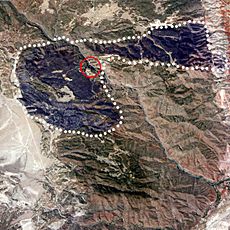
On June 11, 2013, a wildfire started and caused a lot of damage. Most of the park's buildings on both sides of the gorge were destroyed. The fire crossed the gorge just west of the bridge. It burned 3,218 acres (1,302 ha), with 2,156 acres (873 ha) being park property. The fire lasted four days until it was stopped.
The bridge itself was only slightly damaged. About 100 of its 1,292 wooden deck planks needed to be replaced. However, 48 of the park's 52 buildings were destroyed. No visitors, park workers, or animals in the wildlife park were hurt or killed. The Incline Railway was badly damaged, and the aerial tram was completely destroyed.
Park leaders announced on June 13 that the bridge would be fixed and the park rebuilt. Rebuilding started about a week after the fire. It took about five months to tear down all the damaged buildings. A ceremony for the new visitor center happened on January 31, 2014.
Royal Gorge Park Reopens
The Royal Gorge Bridge and Park reopened on August 30, 2014. A big reopening celebration took place on May 8, 2015. This was after $30 million in repairs were completed. The rebuilding plan did not include the wildlife park, so those animals were moved to new homes.
The bridge entrance is open every day from 7 AM until dark. The visitor center, rides, and attractions open at 10 AM, if the weather is good. Some attractions that have been fixed or rebuilt since the fire include:
- A new visitor center with a great view.
- A water clock.
- New gondolas to replace the old aerial trams.
- The Plaza Theater and Historical Expo.
- A Children's Playland.
- The original Royal Rush Skycoaster.
The Cloudscraper Zip Line, which is the highest in North America, opened on March 28, 2015. The damaged Incline Railway and the Silver Rock Railway are not currently listed as open attractions.
In January 2016, the company that runs the park paid the city a record $2.1 million. In 2015, the park had its highest number of visitors ever, nearly 350,000 people. This was a 20% increase from 2012, the last full year before the 2013 fire. Park officials believe that more than 26 million people have visited the park since it first opened in 1929.
Images for kids
See also
 In Spanish: Royal Gorge Bridge para niños
In Spanish: Royal Gorge Bridge para niños



